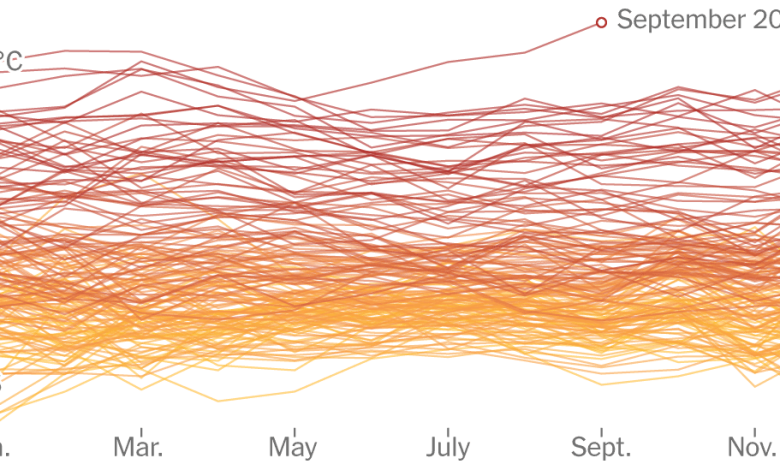I’m a Climate Scientist, and September’s Warmth Freaked Me Out a Little

Staggering. Unnerving. Mind-boggling. Absolutely gobsmackingly bananas.
As global temperatures shattered records and reached dangerous new highs over and over the past few months, my climate scientist colleagues and I have just about run out of adjectives to describe what we have seen. Data from Berkeley Earth released on Wednesday shows that September was an astounding 0.5 degree Celsius (almost a full degree Fahrenheit) hotter than the prior record, and July and August were around 0.3 degree Celsius (0.5 degree Fahrenheit) hotter. 2023 is almost certain to be the hottest year since reliable global records began in the mid-1800s and probably for the past 2,000 years (and well before that).
While natural weather patterns, including a growing El Niño event, are playing an important role, the record global temperatures we have experienced this year could not have occurred without the approximately 1.3 degrees Celsius (2.3 degrees Fahrenheit) of warming to date from human sources of carbon dioxide and other greenhouse gas emissions. And while many experts have been cautious about acknowledging it, there is increasing evidence that global warming has accelerated over the past 15 years rather than continued at a gradual, steady pace. That acceleration means that the effects of climate change we are already seeing — extreme heat waves, wildfires, rainfall and sea level rise — will only grow more severe in the coming years.
I don’t make this claim lightly. Among my colleagues in climate science, there are sharp divisions on this question, and some aren’t convinced it’s happening. Climate scientists generally focus on longer-term changes over decades rather than year-to-year variability, and some of my peers in the field have expressed concerns about overinterpreting short-term events like the extremes we’ve seen this year. In the past I doubted acceleration was happening, in part because of a long debate about whether global warming had paused from 1998 to 2012. In hindsight, that was clearly not the case. I’m worried that if we don’t pay attention today, we’ll miss what are increasingly clear signals.
I wouldn’t be making this argument if I didn’t have strong evidence to back it up; the data we’re getting from three sources tells a worrying story about a world warming more quickly than before. First, the rate of warming we’ve measured over the world’s land and oceans over the past 15 years has been 40 percent higher than the rate since the 1970s, with the past nine years being the nine warmest years on record. Second, there has been acceleration over the past few decades in the total heat content of Earth’s oceans, where over 90 percent of the energy trapped by greenhouse gases in the atmosphere is accumulating. Third, satellite measurements of Earth’s energy imbalance — the difference between energy entering the atmosphere from the sun and the amount of heat leaving — show a strong increase in the amount of heat trapped over the past two decades. If Earth’s energy imbalance is increasing over time, it should drive an increase in the world’s rate of warming.
There are a number of factors driving the acceleration of warming. While the world has made real progress in slowing down the growth of carbon dioxide and other greenhouse gas emissions, they have yet to peak and decline. And on top of this, we are reaping the results of what the climate scientist James Hansen calls our “Faustian bargain” with air pollution. For decades, air pollution from sulfur dioxide and other hazardous substances in fossil fuels has had a strong temporary cooling effect on our climate. But as countries around the world have begun to clean up the air, the cooling effect provided by these aerosols has fallen by around 30 percent since 2000. Aerosols have fallen even more in the past three years, after a decision to largely phase out sulfur in marine fuels in 2020. These reductions in pollution on top of continued increases in atmospheric greenhouse gas concentrations mean that we are encountering some of the unvarnished force of climate change for the first time.
Until recently, climate change was framed as an issue that would affect our children. Today it is nearly omnipresent, and it is impossible to ignore. And very soon, with the acceleration, we will experience even more of its effects: Ice sheets and glaciers will melt faster, extreme weather events will become more frequent, and even more plants and animals will be put at risk of extinction.
Does this acceleration mean that warming is happening faster than we thought or that it is too late to avoid the worst impacts? Not necessarily. Amazingly enough, this acceleration quite closely matches what climate models have projected for this period. In other words, scientists have long foreseen a possible acceleration of warming if our aerosol emissions declined while our greenhouse gas emissions did not. That’s what we’re now seeing. This may not make you feel much better about the future of warming but should at least make you feel better about our models and the power of science to prepare us for what’s to come.
It’s now clear that we can control how warm the planet gets over the coming decades. Climate models have consistently found that once we get emissions down to net zero, the world will largely stop warming; there is no warming that is inevitable or in the pipeline after that point. Of course, the world will not cool back down for many centuries, unless world powers join in major efforts to remove more carbon dioxide from the atmosphere than we add. But that is the brutal math of climate change and the reason we need to speed up efforts to reduce emissions significantly.
On that front, there is some reason for cautious hope. The world is on the brink of a clean energy transition. The International Energy Agency recently estimated that a whopping $1.8 trillion will be invested in clean energy technologies like renewables, electric cars and heat pumps in 2023, up from roughly $300 billion a decade ago. Prices of solar, wind and batteries have plummeted over the past 15 years, and for much of the world, solar power is now the cheapest form of electricity. If we reduce emissions quickly, we can switch from a world in which warming is accelerating to one in which it’s slowing. Eventually, we can stop it entirely.
We are far from on track to meet our climate goals, and much more work remains. But the positive steps we’ve made over the past decade should reinforce to us that progress is possible and despair is counterproductive. Despite the recent acceleration of warming, humans remain firmly in the driver’s seat, and the future of our climate is still up to us to decide.
Graphics by Sara Chodosh
Zeke Hausfather is the climate research lead at Stripe and a research scientist at Berkeley Earth.
The Times is committed to publishing a diversity of letters to the editor. We’d like to hear what you think about this or any of our articles. Here are some tips. And here’s our email: [email protected].
Follow The New York Times Opinion section on Facebook, Twitter (@NYTopinion) and Instagram.




